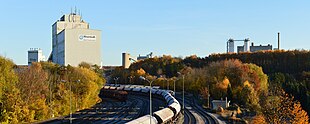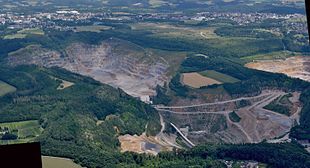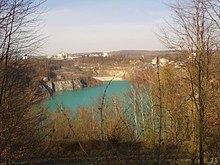Flandersbach lime works
The Flandersbach der Rheinkalk lime works in the Wülfrath district of Rohdenhaus was founded in 1903 and has been in operation ever since. It is the largest lime works in Europe.
Operating areas in the Flandersbach plant
Quarry
The two quarries, Grube Rohdenhaus and Silberberg , which are currently being dismantled, are located on the factory premises . There are other pits that are no longer mined, these are the Dachskuhle and Prangenhaus quarries . The Prangenhaus pit is used as a sedimentation basin by the plant's drainage system.
Processing and stone grinding systems
The material extracted in the quarry is crushed in several crushers and cleaned of adhering debris in a rock wash. A part is further crushed in mills to different grain sizes between 0.09 and 5 mm. Another part is collected as input material for the kilns on stone stores or sold as chippings.
Burning operation
Four rotary kilns and six shaft kilns are used to produce quicklime with different reactivity . Natural gas and lignite dust are used as fuel .
Finishing and loading
After sieving into different grain sizes, the burnt lime is either loaded directly as lump lime by truck or wagon or ground into fine lime in lime mills . The fine lime is sold directly in container vehicles or only provided with aggregates in mixing plants in order to obtain special properties of the lime, e.g. B. to increase the absorption of pollutants in power plant exhaust gases. The Angertal Railway is used to transport the lime to the steelworks and lignite opencast mines in the Rhine / Ruhr area .
Emissions
The plant's emissions have been reported to the EU pollutant emissions register since 2008 if their amount exceeds the reporting thresholds. The data can be called up by entering "Wülfrath" in the "Location" field under "Data → Companies → Search".
Individual evidence
- ↑ Thomas Peter: Wülfrath: A look at Europe's largest lime works. In: Rheinische Post . August 22, 2014, accessed June 4, 2015 .
- ^ Pollutant Emissions Register Germany. Federal Environment Agency, accessed on May 15, 2019 .
Coordinates: 51 ° 17 '52.1 " N , 7 ° 0' 53.3" E



